If you like BIG Cosmic story lines, then check out
the BIG ideas in Jim McPherson’s Phantacea!
Phantacea: 1977
Editor/Writer: Jim McPherson
 Jim McPherson had big ideas even at the beginning of his writing career. Right out of university he put his creative writing degree to work crafting an epic in his Canadian comic, Phantacea. There are so many ideas and characters, in fact, that it is sometimes hard to keep track of what is going on and which cosmic hero is in action. But, you have to give creator McPherson credit. He was not afraid to challenge his readers and attempt to drown them in a soup of a new mythology. You will see that this mythology, which started in a somewhat ordinary looking superhero comic, has continued to today. It has gone through stages from comics to a graphic novel to several prose books.
Jim McPherson had big ideas even at the beginning of his writing career. Right out of university he put his creative writing degree to work crafting an epic in his Canadian comic, Phantacea. There are so many ideas and characters, in fact, that it is sometimes hard to keep track of what is going on and which cosmic hero is in action. But, you have to give creator McPherson credit. He was not afraid to challenge his readers and attempt to drown them in a soup of a new mythology. You will see that this mythology, which started in a somewhat ordinary looking superhero comic, has continued to today. It has gone through stages from comics to a graphic novel to several prose books.
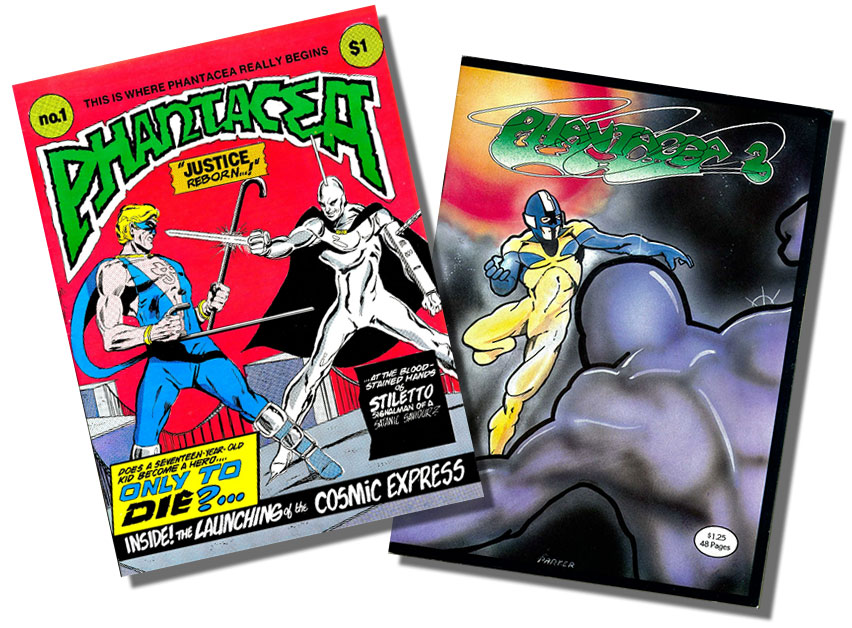
Probably the main draw for those that have been reading comics for the last 20 years is the fact that the artist/letterer of this first issue is none other than Dave Sim, pre-Cerebus. That’s right, Dave Sim is a main component of an archetypical superhero comic. Though labeled by creator McPherson as “only a hired gun,” Sim gives this comic a visual air of professionalism, especially in the lettering department. In fact, it may be the lettering that inhibits it from entering the territory of the “big myth” that becomes more evident in the second issue. I say this partially with admiration, because Sim is completely in control of this skill. And we are talking hand lettering, folks.This 1978 comic was done long before computer fonts. There is a great sense of variety and fun in the lettering alone, from the balloons to the sound effects to the titles. On the other hand, the mainstream superhero style of this lettering is somewhat deceptive, in that the content ventures far beyond the standard skintight costume hero fare. Sim’s actual storytelling style is reminiscent of some of the more experimental artists of that time, such as Neal Adams and Jim Steranko, while his figure rendering style seems to point towards a combination of John Byrne, Gene Colan, and Jim Aparo.
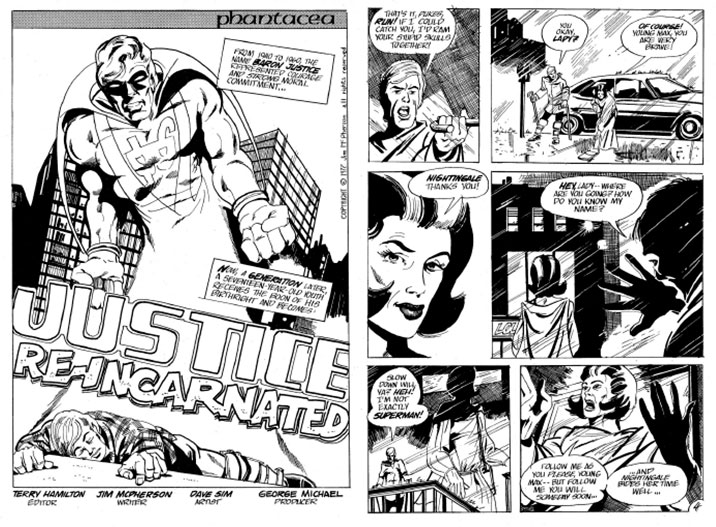
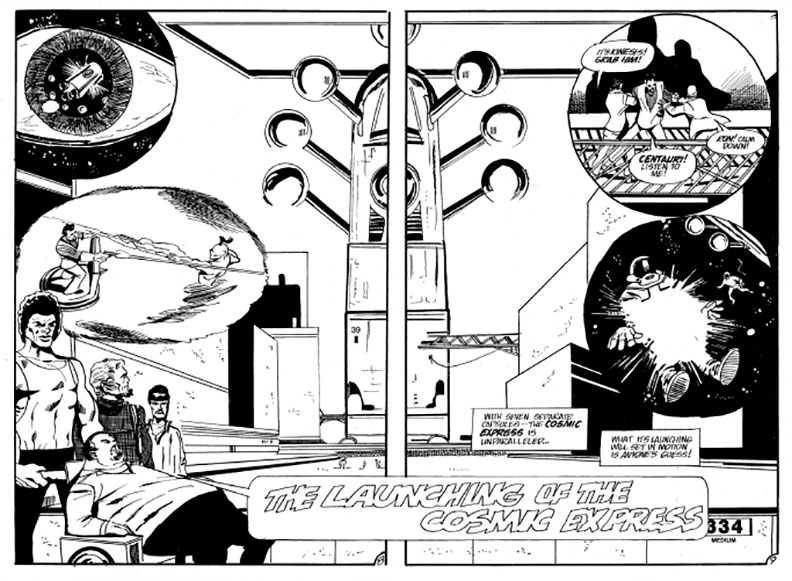
Some of the storytelling gimmicks (such as all the angled panels, for example) seem to indicate that Sim was biting off a little more than he could chew this early in his career. In Cerebus he would use out of the ordinary panel layouts to much better effect. Here these attempts draw too much attention to themselves and take the reader out of the story (see a few examples above and below). I will let McPherson relay his interactions with Sim:
I connected with a fellow calling himself Terry Hamilton and said I was thinking about launching my own comic book series. Terry worked at my neighborhood comic shop, which still exists, and he hired Sim, whom I believe he knew from Ontario. As I recall he wouldn’t tell me his [Sim’s] name in case I cut him out of process in terms of future issues. Terry was my intermediary for the first issue. And he was right. I’d already cut him out of Phantacea by second issue and contacted Sim myself, possibly through Star*Reach, though can’t recall precisely. Sim and I were never partners. He worked for hire. I wrote every word and provided him with a block-out of every page panel-by-panel. I drew, more like squiggled, everything out (minus balloons or serious sketches, just layouts) and sent photocopies to him along with script (description, caption, word balloons). I did that for every Phantacea artist and virtually all of them followed my layouts for the most part.
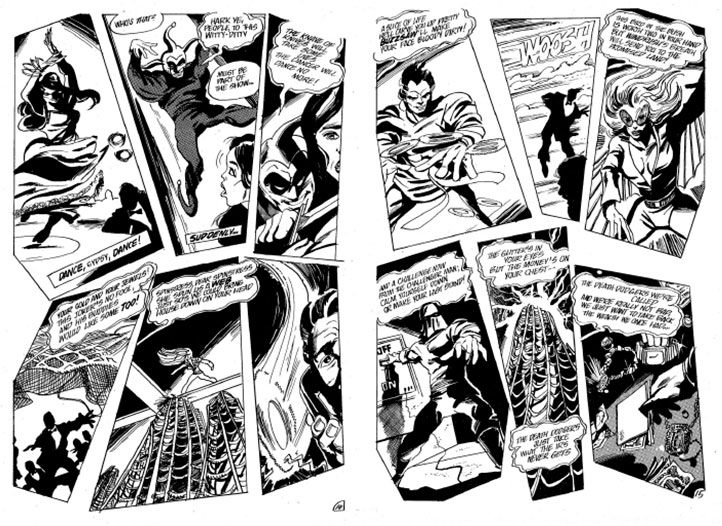
Sim would obviously have other things cropping up in his schedule soon, as Jim told me via email below:
Sim thought Baron Justice was a winner. I disagreed; he (TJ Maxwell) was just another character who would appear once in awhile in Phantacea. (As it turned out, he only appeared twice, albeit only once as BJ.) I was prepared to publish another series, called The Justice Chronicles, featuring TJ-BJ, his grandparents, father and mother, the Signallers and Death Dodgers, et al, but Sim was into Cerebus by then and seemed disinclined to carry on hiring himself out. Just as well. My ambitions were much bigger than my pocketbook.
And what is the story contained within this ambitious epic, you ask? Well, I will let McPherson entertain you again, from the foreword in issue two.
During Vedic times, an extraterrestrial race of super-powerful creatures came down to Earth. They were the Devas. Their patriarch, their progenitor in fact, was Dark Sedon. Under his somewhat insane leadership, the devas sought to assert dominance over the indigenous peoples of the Earth. Unexpectedly, the Earthlings proved too rebellious, too difficult to control. The devas were forced to flee to a continent created by Sedon in the Pacific Ocean. This continent was fashioned in the Mad God’s visage, hence, is called Sedon’s Head. To keep the outer-Earth from interfering with life on the Head, and vice versa, Sedon raised a barrier dome over his Headworld. This dome is invisible and intangible. It may be described as existing in the same Time-Space continuum as Earth but on a different plane of reality. The dome is formed out of Sedon’s own essence and is called the Cathonic Zone.

And that is less than half of the foreword to issue two! Added to that are the massive amounts of super characters, with names that would easily fit into the then current issue of Adam Strange, or an issue of any Fourth World comics (New Gods, et al) from the febrile imagination of Jack Kirby. Names like Vayu Maelstrom, the CosmiCar, Mr. No Name, and the Damnation Brigade. Issue one tries to set up the basic story line, but in my opinion, there are so many characters introduced so frequently, it’s sometimes hard to keep track of that story line. But you have to give McPherson credit…he aims very high. Below are the big plans McPherson had for his tale:
I had grandiose notions. I’d keep on doing superheroes with Justice Chronicles, would get into sci-fi stuff with Mik Starrus, Weirworld, Uncle Universe etc, and devote the Phantacea flagship comic, Phantacea itself, to my real love, mythology – i.e. devils, demons, deviants and the Damnation Brigade, the sons and daughters of some of the above (1/2 of whom were Summoning Children). Rather, to updating mythological-style story lines to modern times and thereby create a new mythology (or mythos, as I prefer). Which is what won out; and is still winning out with the Phantacea novels, mini-novels and e-books.
When I mentioned to McPherson via email that there seemed to be just too much going on this early in the comic, he responded with
Actually I thought that would pique interest in Phantacea. Further to that, I’m not sure about the correct term but ‘character dumps’ rather than ‘information dumps’ comes to mind. Also, not having heroes and villains per se – hence Anheroic Fantasy Illustrated – was part of my scheme from the very beginning. People tend to do what seems right for themselves, not for others. In other words, we’re all heroes of our own narrative. I see no reason why comic book or television or movie characters should be any different. Of course, it could be I read the Iliad and suchlike too many times in my childhood and too many Victorian and similar novels in my youthful years of later on in elementary and early on high school. I just thought that was the way it was done – get the required dumpage over with straightaway then move them along their own pathways afterwards. Times were also different. Patience was still a virtue, not a necessity. Instant gratification was not an expectation. That said, I was after action as often as could be per story sequence and hoped to hive off said stories in aforementioned three directions: ones represented by BJ/Centauri Island storyline; one by Helios on the Moon storyline; and the main one by Damnation Brigade leading to Sedon’s Head and devil-gods.
It was planned for some of these characters to leave Phantacea and move into his planned other comic, The Justice Chronicles. I have a feeling the second title would have leaned more in an actual superhero direction, leaving Phantacea to become more the fantasy book it should have been from the start. And speaking of a more fantasy oriented start, let’s start with the first thing you see; the cover (seen at top). The new logo is a blatant rip off or fond homage to Roger Dean, he of the Yes album covers that were so popular in the 70s (I know, I have them all…in fact, the wallpaper on the computer I am writing this article on is a Dean painting). It sets a new tone. The mythology is also given a new pace, partially because each “chapter” is now done by a different artist. Unfortunately, it appears each artist also did his own lettering, some of which is either devoid of character, fairly unprofessional, or both. But, the good thing is that, for the most part, we are not seeing the sound effects heavy, superhero comic standard type letting Sim employed in the first issue (though he does appear in a chapter in this second issue). As for all these new artists and how they became involved, McPherson said
I met Parker the same way I came across Terry Hamilton, via the owner of the local comic shop. Terry was associated with something called Stampart. Together, they did this funny animal series called Fog City Comics. Sean Newton may have been involved in Fog City. Sim might have been, too. Ian Bateson found me, also via the Comic Shop as I recall. I’d been trolling some local animation studies for artists and letterers and Newton might have come to me that way.
The first story, Starrus Yajur & the Ubiquitous Uncle Universe, focuses on hero Mikelangleo Starrus. Artist Gordon Parker’s style makes me think of a black and white version of countryman Ken Steacy’s artwork, albeit less expertly executed, complete with airbrush renderings. However, the transfer lettering, all in caps (with very little breathing room around the strips and too much within the balloons) gives it an unprofessional cut and paste look. The storytelling, though, is more clear than Sim’s, so it is easier to tell what is going on without a ton of effort. As to the various levels of skill in the lettering department, McPherson said
Lettering is one of the great bugaboos of comics. No matter how good the artwork is otherwise, without decent lettering it’s trash. I wasn’t going to do any lettering and no other artist I ever hired wanted to either. Didn’t give them a choice, however, and it was only after they absolutely refused to do their own lettering that I looked elsewhere, with I’ll acknowledge limited success. So, yes, at least in theory every artist I hired was supposed to provide lettering for the sequence they drew. Some came back disastrously and, yes again, there were times I had to hire letterers either before or after fact and hated the result. Curiously, even if I liked their work, the letterers themselves found it too arduous a task so they never deigned to work with me again, not even if I offered them a howsoever minuscule raise.
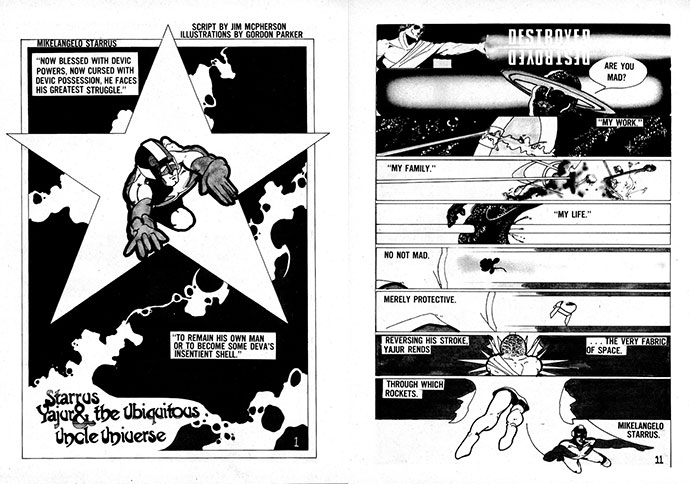
The second story centers on Captain Dmetri Diomad, of Cosmicar Four, who thinks he’s back in a Vietnamese Jungle when he’s actually somehow ended up on the Hidden Continent of Sedon’s Head. Sean Newton’s art in The Soldier’s Trilogy, Part 1: Vetala is a very nice linear style along the lines of Oz/Age of Bronze artist Eric Shanower, and has some very nice inking as well (see two pages below).

The actual storytelling is a bit pedestrian compared to the other artists, but it is also a nice resting place, because of the more simplistic panel compositions. There is also more breathing space around the figures, which adds to the feeling of a more restful and contemplative story, despite the fact that it has an age changing vampire woman riding a giant vulture! As to Newton’s skillset, McPherson stated
…I was pleased with result. He was playful, too. The wooden leg the Vetala-hag is shown dragging along behind her comes from my description of what he had to draw, which went something like: “She’s so old and arthritic it’s like she’s dragging along a wooden leg behind her.” It was meant metaphorically, as in she could barely walk, but he took it literally and I left the leg in, just because I like playing around as well. But, to answer your question, I believe he was an animator. I know I would have hired him to carry on the Vetala-Soldier storyline that Verne Andru took over. Except he moved to Montreal in order to work on the Heavy Metal movie and I never came across him again.
The next chapter, Meet: the Indescrible Mr. Noname! heralds the reappearance of Sim as artist/letterer. It makes more sense this time, as the title character is a more traditional comic type character in the vein of The Blob. Another character, The Gypsium Man, appears in a very Neal Adams-esqe splash page (complete with a big, toned title balloon). It is the frenzied layouts of Sim’s that makes me doubt the writer’s assertion that everyone followed his layouts…how, then, were they all so different?

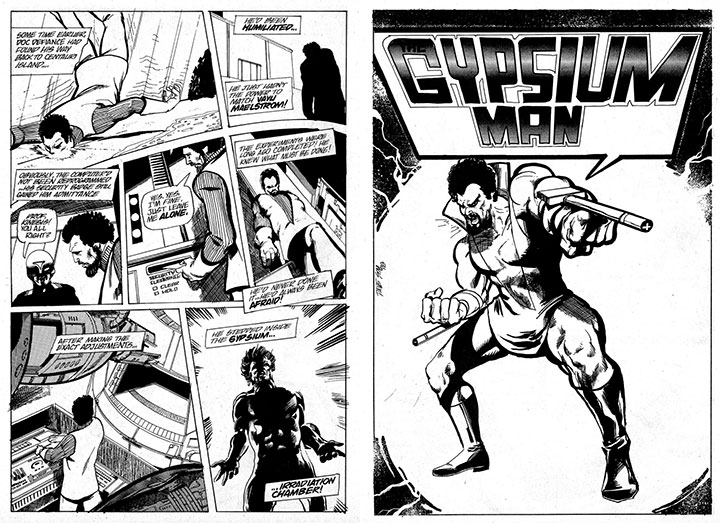
The last story heads back into a more fantasy laden landscape, and features Vayu Maelstrom, a Master Deva, a protector of the Headworld and a Byronic Nucleoid. Cosmic enough for you yet? The art by Ian Bateson, is a pointillistically rendered combination of Richard Corben and First Kingdom artist Jack Katz. The lettering this time is both fitting to the visual style of the story (complete with that old presstype computer style so popular back in the 70s), and easily readable.
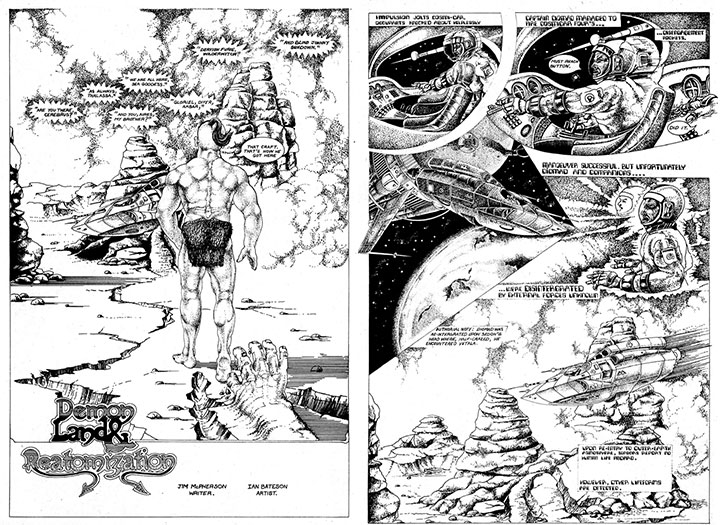
I think Bateson is the best visual fit to this epic (see pages above and below), even if some of the figure stances are a little awkward and stiff. Interestingly, a character called “Cerebrus” appears in this story…but he is far from an earth pig! A huge battle ensues between the main character and a “Devic Demon,” the living mountain. Soon after that, we are introduced to the aforementioned “multi-talented” Damnation Brigade, composed of characters with fanciful names like Wilderwitch, Blind Johnny Sundown, and The Awesome Akbar. As I said earlier much of this seems to be setting up the massive storyline McPherson would labor on for the next 30 years.
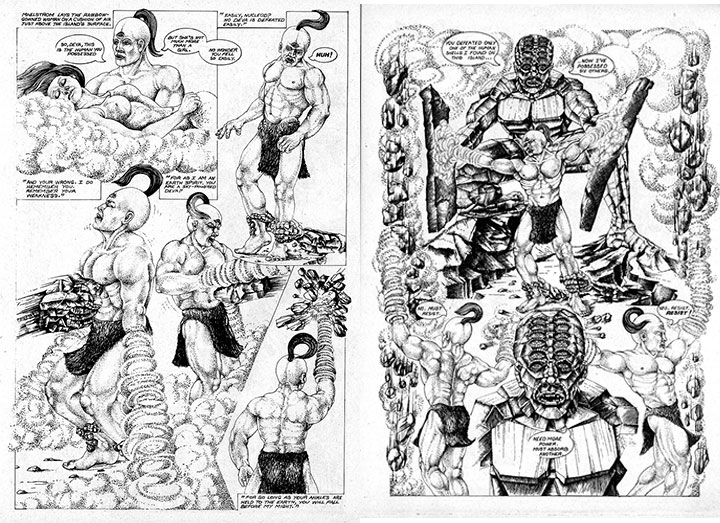
 Though these two independent comics have their rough spots, they are full of energy and ideas. And though described by McPherson as a “money making venture”, the content sits perfectly in the stylistic bookshelves populated by the fantasy fanzines of that time such as Infinity. Author McPherson has a massive website (fitting the massive nature of his project) that you can see here. The author does a lot of traveling to service his interests, and he talks below about his plans for both and how they have changed over the years.
Though these two independent comics have their rough spots, they are full of energy and ideas. And though described by McPherson as a “money making venture”, the content sits perfectly in the stylistic bookshelves populated by the fantasy fanzines of that time such as Infinity. Author McPherson has a massive website (fitting the massive nature of his project) that you can see here. The author does a lot of traveling to service his interests, and he talks below about his plans for both and how they have changed over the years.
When I was working I wrote on weekends. All sorts of stories came out of me in those days but it wasn’t until computers came along in the early 1990s that I got back into long fiction – and the Phantacea mythos. That’s still the medium I prefer – don’t have to deal with artists and letterers and distributors – but I don’t know that long fiction really sells anymore. I’m hopeful getting into e-books, with their speaking-book aspects, will make a big difference financially but I never was much good at marketing so who can say. I’ve scripts for the entire Phase One series that I started work on in 1980s and I’ve a Wilderwitch story written for a graphic novel but I haven’t the bucks to get back into comics as much as I love the medium. (I stopped reading, let alone collecting comics, circa 1990.) I enjoy working on web-pages and doing graphics for the medium. It’s something I can do myself, and it’s probably what I’ve enjoyed the most, but there’s no denying that starting out the comic books, writing the scripts, coaxing out the artwork, the whole process, was a highlight reel period for me in my own timeline. Lately, I’m mostly doing the innards for the next Phantacea Publications offering, which will be an e-book version of War-Pox. Once Verne finishes the cover for “Goddess Gambit,” Book Three of ‘The Thrice-Cursed Godly Glories’ trilogy, I’ll get it print ready and published. After that I’ll start counting pennies and deciding which conventions I can afford to attend in 2012. Not very exciting, I’ll grant you, but I still hope to make some serious money via the Phantacea Mythos. Am entertaining offers, as it were. Beyond Phantacea, life goes on. I’d planned on going on safari in the new year but Al Shabab’s going crazy in Kenya and that’s where I wanted to go. Travelling takes a big bite out of ever-limited financing but it’s what I enjoy most. Other than writing, doing graphics and taking photos, that is.
Big time thanks goes out to Jim McPherson for answering a host of questions from me via email. I am also indebted to him for letting me make the pdfs available, considering he still sells the comics via his website. I also need to thank Jason Schachter, as these are two of the many zines he has forwarded scans of to me. Download the pdfs to see it all! You can also order his graphic novel, novels and other paraphernalia related to this most adventurous of publications, Phantacea!
Ken Meyer Jr.
kenmeyerjr@yahoo.com












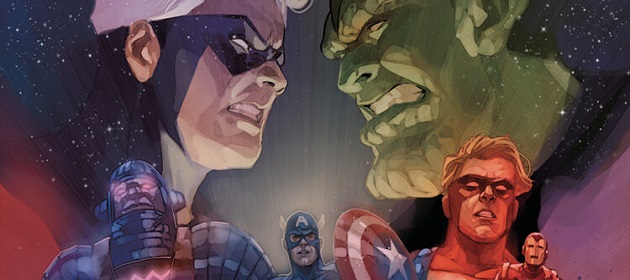
Wow, fantastic!
My name is Jim McPherson and I approved of this posting.
Ha, thank you, Mr. President!
Great work in representing these, Ken! As always, this is very enjoyable.
Thanks Richard (and Billy) for commenting!
Awesome! Just freakin’ awesome!
Hey, Speech, thanks a bunch!
Pingback: Nuclear Aardvark | Phantacea Publications